The Ecological Potential of Poplars (Populus L.) for City Tree Planting and Management: A Preliminary Study of Central Poland (Warsaw) and Silesia (Chorzów)
Abstract
:1. Introduction
- Achieving quite large dimensions connected to rapid growth and an increase in biomass (e.g., LAI);
- Having a quick impact on the local microclimate, e.g., shading, transpiration, protection against wind and noise, etc.;
- Their phytoremediation abilities like the filtration of particular matter (PM) or gas pollution from air or the absorption of heavy metals from water and soil;
- Their high adaptability to various soil and water conditions;
- Their considerable tolerance for pollution of air, water, and soil;
- Their mass production of nursery material;
2. Methodology
2.1. Research Framework
2.2. Materials and Methods
3. Results and Discussion
- Obtaining quick visual results in urban green spaces and cityscapes;
- Reinforcing the environment and shaping a favorable microclimate in a relatively short time period;
- Covering and masking buildings and unattractive objects and views, e.g., warehouses, landfills and heaps, etc.
3.1. The Contribution of Poplars to the Urban Environment
3.2. The Fast Increments of Poplars
3.3. The Short Lifespan of Poplars
- Typical botanical species, e.g., white poplar (P. alba L.) and black poplar (P. nigra L.);
- The intra- and inter-sectional hybrids of the balsam poplar TACAMAHACA and some cultivated varieties, e.g., P. simonii Carrière and P. maksymowiczii Henry, as well as balsam poplar hybrids, e.g.,: P. ×berolinensis Dippel, and hybrids like ‘NE 49’ and ‘NE 42’ (Table 1).
3.4. The Use of Berlin Poplar in the Afforestation of Urban Landscapes—Field Research
- Case A. The research area of Rakowiecka Street in Warsaw, Poland.
- Case B. The research area of Ziętek Promenade in Silesia Park in Chorzów, Poland.
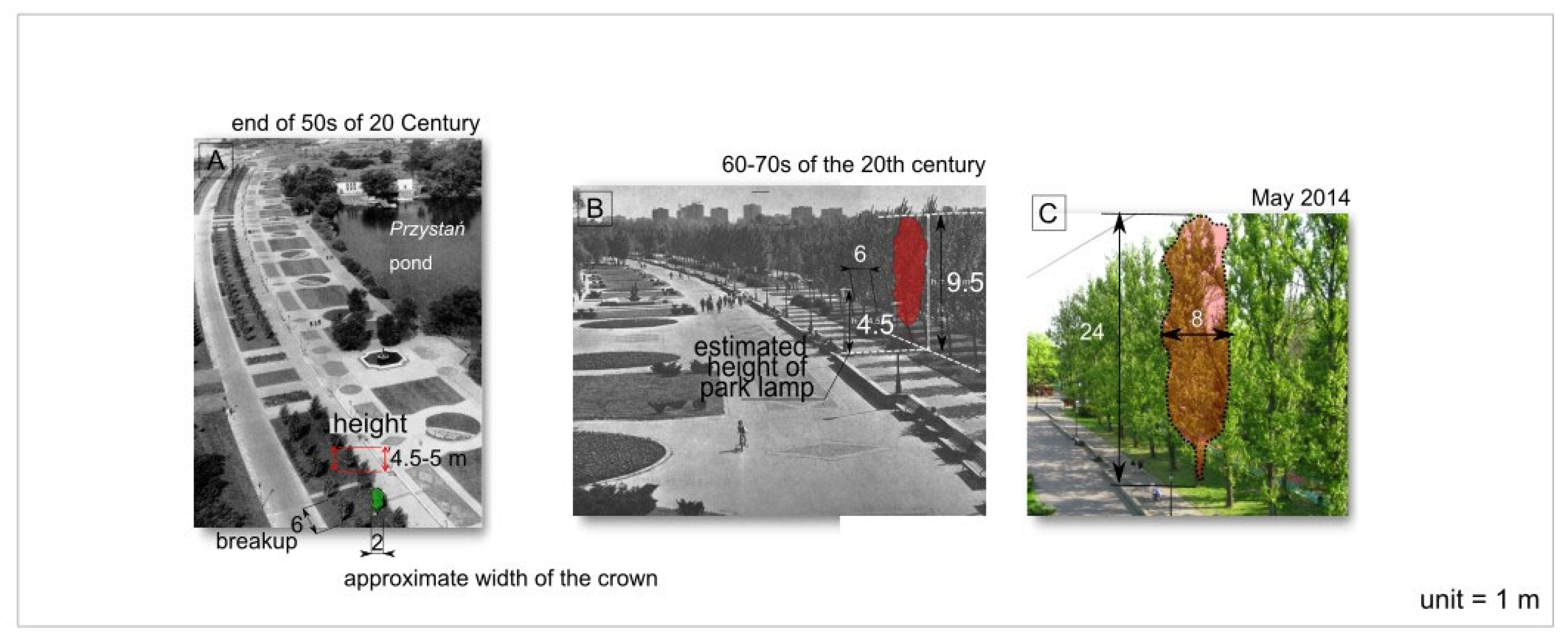
3.5. Poplar in Cities as Suitable but Under-Rated Trees in Urban Greenery
3.6. Benefits of Poplars against Other Species for Cities
4. Conclusions
- Berlin poplars serve, in the presented research, as exemplars of trees that have been successfully utilized in parks and urban street settings. They exhibit rapid growth even under adverse urban conditions, such as drought, limited rooting space, and pollution exposure.
- While poplar trees can demonstrate acceptable longevity in urban conditions, their survival rates mayvary between park and street environments, e.g., urban stressors have caused the premature decline of Populus ×berolinensis on Rakowiecka street in Warsaw (Poland).
- The literature and empirical evidence suggest that poplar trees’ alleged short lifespans are less pronounced in downtowns, where trees struggle to reach maturity. It prompts a call to recognize various poplar cultivars as resilient tree species capable of enhancing urban biodiversity.
- Proper management practices, including root system care and selective pruning, are crucial for effectively utilizing poplar trees in urban green spaces, such as street tree lanes and park alleys. The selection of poplar cultivars tailored to specific urban functions is paramount for achieving the desired outcomes. Careful consideration should be given to avoiding female cultivars that produce abundant seed down.
- Given their rapid growth, adaptability, and positive environmental impact, poplar trees can be readily replaced in urban spaces through cyclic renewal practices akin to urban plantation schemes. A notable example is the reforestation of the main promenade in Silesia Park in Chorzów (Poland), where young poplar saplings are estimated to completely replace large old trees over 25 m in height within approximately 20 years. This highlights their significant role in urban landscapes from both ecological and aesthetic perspectives.
- Our studies on the growth of Populus ×berolinensis (Cases A and B) are of a pilot nature. However, the obtained results encourage continued research into the wide use of poplars in cities in the context of challenges related to climate change and maintaining tree cover in urban forests and urban green spaces in the future.
Author Contributions
Funding
Data Availability Statement
Acknowledgments
Conflicts of Interest
References
- Fischer, L.K.; Neuenkamp, L.; Lampinen, J.; Tuomi, M.; Alday, J.G.; Bucharová, A.; Cancellieri, L.; Casado-Arzuaga, I.; Čeplová, N.; Cerveró, L.; et al. Public attitudes toward biodiversity-friendly greenspace management in Europe. Conserv. Lett. 2020, 13, e12718. [Google Scholar] [CrossRef]
- Dade, M.C.; Mitchell, M.G.E.; Brown, G.; Rhodes, J.R. The effects of urban greenspace characteristics and socio-demographics vary among cultural ecosystem services. Urban For. Urban Green. 2020, 49, 126641. [Google Scholar] [CrossRef]
- WHO. Urban Green Spaces: A Brief for Action; World Health Organization, Regional Office for Europe: Bonn, Germany, 2017; Available online: https://www.euro.who.int/en/health-topics/environment-and-health/urban-health/publications/2017/urban-green-spaces-a-brief-for-action-2017 (accessed on 1 October 2021).
- Forman, R.T.T. Values of large-versus-small urban greenspaces and their arregement. In Why Cities Need Large Parks; Murray, R., Ed.; Large Parks in Large Cities; Routledge: London, UK; New York, NY, USA, 2021; pp. 18–43. [Google Scholar]
- Matos, P.; Vieira, J.; Rocha, B.; Branquinho, C.; Pinho, P. Modeling the provision of air-quality regulation ecosystem service provided by urban green spaces using lichens as ecological indicators. Sci. Total Environ. 2019, 665, 521–530. [Google Scholar] [CrossRef]
- Borowski, J.; Fortuna-Antoszkiewicz, B.; Łukaszkiewicz, J.; Rosłon-Szeryńska, E. Conditions for the effective development and protection of the resources of urban green infrastructure. E3S Web Conf. 2018, 45, 00010. [Google Scholar] [CrossRef]
- Graça, M.; Queirós, C.; Farinha-Marques, P.; Cunha, M. Street trees as cultural elements in the city: Understanding how perception affects ecosystem services management in Porto, Portugal. Urban For. Urban Green. 2018, 30, 194–205. [Google Scholar] [CrossRef]
- Konijnendijk, C.C. Evidence-based guidelines for greener, healthier, more resilient neighbourhoods: Introducing the 3–30–300 rule. J. For. Res. 2022, 34, 821–830. [Google Scholar] [CrossRef]
- Ziter, C.; Pedersen, E.J.; Kucharik, C.J.; Turner, M.G. Scale-dependent interactions between tree canopy cover and impervious surfaces reduce daytime urban heat during summer. Proc. Natl. Acad. Sci. USA 2019, 116, 7575–7580. [Google Scholar] [CrossRef] [PubMed]
- Yang, J.; Chang, Y.; Yan, P. Ranking the suitability of common urban tree species for controlling PM2.5 pollution. Atmos. Pollut. Res. 2015, 6, 267–277. [Google Scholar] [CrossRef]
- Yang, Q.; Wang, H.; Wang, J.; Lu, M.; Liu, C.; Xia, X.; Yin, W.; Guo, H. PM2.5-bound SO42– absorption and assimilation of poplar and its physiological responses to PM2.5 pollution. Environ. Exp. Bot. 2018, 153, 311–319. [Google Scholar] [CrossRef]
- Kis, B.; Avram, S.; Pavel, I.Z.; Lombrea, A.; Buda, V.; Dehelean, C.; Şoica, C.; Yerer, M.B.; Bojin, F.; Folescu, R.; et al. Recent Advances Regarding the Phytochemical and Therapeutic Uses of Populus nigra L. Buds. Plants 2020, 9, 1464. [Google Scholar] [CrossRef]
- Madejón, P.; Ciadamidaro, L.; Marañón, T.; Murillo, J. Long-Term biomonitoring of soil contamination using poplar trees: Accumulation of trace elements in leaves and fruits. Int. J. Phytoremediat. 2013, 15, 602–614. [Google Scholar] [CrossRef] [PubMed]
- Roy, S.; Byrne, J.; Pickering, C. A systematic quantitative review of urban tree benefits, costs, and assessment methods across cities in different climatic zones. Urban For. Urban Green. 2012, 11, 351–363. [Google Scholar] [CrossRef]
- Bamwesigye, D.; Fialova, J.; Kupec, P.; Yeboah, E.; Łukaszkiewicz, J.; Fortuna-Antoszkiewicz, B.; Botwina, J. Urban Forest Recreation and Its Possible Role throughout the COVID-19 Pandemic. Forests 2023, 14, 1254. [Google Scholar] [CrossRef]
- Bose, A.; Moser, B.; Rigling, A.; Lehmann, M.; Milcu, A.; Peter, M.; Rellstab, C.; Wohlgemuth, T.; Gessler, A. Memory of environmental conditions across generations affects the acclimation potential of scots pine. Plant Cell Environ. 2020, 43, 1288–1299. [Google Scholar] [CrossRef] [PubMed]
- Pretzsch, H.; Biber, P.; Uhl, E.; Dahlhausen, J.; Schütze, G.; Perkins, D.; Rötzer, T.; Caldentey, J.; Koike, T.; van Con, T.; et al. Climate change accelerates growth of urban trees in metropolises worldwide. Sci. Rep. 2017, 7, 15403. [Google Scholar] [CrossRef] [PubMed]
- Crous-Duran, J.; Graves, A.; Jalón, S.; Kay, S.; Tomé, M.; Burgess, P.; Giannitsopoulos, M.; Palma, J. Quantifying regulating ecosystem services with increased tree densities on european farmland. Sustainability 2020, 12, 6676. [Google Scholar] [CrossRef]
- Zhang, M.; Yuan, N.; Li, M. Evaluation of the growth, adaption, and ecosystem services of two potentially-introduced urban tree species in guangzhou under drought stress. Sci. Rep. 2023, 13, 3563. [Google Scholar] [CrossRef] [PubMed]
- Vaz, A.; Castro-Díez, P.; Godoy, Ó.; Alonso, Á.; Vilà, M.; Saldaña, A.; Marchante, H.; Bayón, Á.; Silva, J.S.; Vicente, J.R.; et al. An indicator-based approach to analyse the effects of non-native tree species on multiple cultural ecosystem services. Ecol. Indic. 2018, 85, 48–56. [Google Scholar] [CrossRef]
- Lima, I.; Scariot, A.; Giroldo, A. Impacts of the implementation of silvopastoral systems on biodiversity of native plants in a traditional community in the brazilian savanna. Agrofor. Syst. 2016, 91, 1069–1078. [Google Scholar] [CrossRef]
- Murray, R. Why cities need large parks. In Why Cities Need Large Parks. Large Parks in Large Cities; Murray, R., Ed.; Routledge: London, UK; New York, NY, USA, 2021; pp. 11–17. [Google Scholar]
- Bell, J.N.B.; Treshow, M. Air Pollution and Plant Life. [Zanieczyszczenie Powietrza a Życie Roślin]; WNT: Warszawa, Poland, 2016. [Google Scholar]
- Lo, A.; Byrne, J.; Jim, C.Y. How climate change perception is reshaping attitudes towards the functional benefits of urban trees and green space: Lessons from Hong Kong. Urban For. Urban Green. 2017, 23, 74–83. [Google Scholar] [CrossRef]
- Gawroński, S.W. Phytoremediation Role of Plants in Urbanized Areas. In Trees and Shrubs in Environmental Reclamation, Mat. IX Zjazdu Polskiego Towarzystwa Dendrologicznego; Nowak, G., Kubus, M., Sobisz, Z., Eds.; Konferencja Naukowa, Wirty-Ustka, 19–22 września 2018 r.; Polish Dendrology Society: Szczecin, Poland, 2018; pp. 19–27. [Google Scholar]
- Łukaszkiewicz, J. Zadrzewienia w Krajobrazie Miasta: Wybrane Aspekty Kształtowania Struktury i Funkcji [Trees in the City Landscape: Selected Aspects of Shaping the Structure and Function]; SGGW: Warsaw, Poland, 2019. [Google Scholar]
- Łukaszkiewicz, J.; Fortuna-Antoszkiewicz, B. The influence of woodlots on the photoclimate of green areas and the quality of recreation. In Public Recreation and Landscape Protection–with Environment Hand in Hand; Fialová, W.J., Ed.; Mendel University: Brno, Czech Republic, 2022; Volume 13, pp. 385–389. [Google Scholar] [CrossRef]
- Popek, R.; Gawronska, H.; Gawronski, S.W. The level of particulate matter on foliage depends on the distance from the source of emission. Int. J. Phytoremediat. 2015, 17, 1262–1268. [Google Scholar] [CrossRef] [PubMed]
- Sgrigna, G.; Sæbø, A.; Gawroński, S.; Popek, R.; Calfapietra, C. Particulate Matter deposition on Quercus ilex leaves in an industrial city of central Italy. Environ. Pollut. 2015, 197, 187–194. [Google Scholar] [CrossRef] [PubMed]
- Chambers-Ostler, A.; Walker, H.; Doick, K.J. The role of the private tree in bringing diversity and resilience to the urban forest. Urban For. Urban Green. 2024, 91, 127973. [Google Scholar] [CrossRef]
- Gillner, S.; Vogt, J.; Tharang, A.; Dettmann, S.; Roloff, A. Role of street trees in mitigating effects of heat and drought at highly sealed urban sites. Landsc. Urban Plan. 2015, 143, 33–42. [Google Scholar] [CrossRef]
- Jim, C.Y. Urban Heritage Trees: Natural-Cultural Significance Informing management and Conservation. In Advances in 21st Century Human Settlements; Springer: New York, NY, USA, 2017; pp. 279–305. [Google Scholar] [CrossRef]
- Jacobsen, R.M.; Birkemoe, T.; Evju, M.; Skarpaas, O.; Sverdrup-Thygeson, A. Veteran trees in decline: Stratified national monitoring of oaks in Norway. For. Ecol. Manag. 2023, 527, 120624. [Google Scholar] [CrossRef]
- Carmichael, C.; McDonough, M.H. The trouble with trees? Social and political dynamics of street tree-planting efforts in Detroit, Michigan, USA. Urban For. Urban Green. 2018, 31, 221–229. [Google Scholar] [CrossRef]
- Nowak, D.J.; Aevermann, T. Tree compensation rates: Compensating for the loss of future tree values. Urban For. Urban Green. 2019, 41, 93–103. [Google Scholar] [CrossRef]
- Riedman, E.; Roman, L.A.; Pearsall, H.; Maslin, M.; Ifill, T.; Dentice, D. Why don’t people plant trees? Uncovering barriers to participation in urban tree planting initiatives. Urban For. Urban Green. 2022, 73, 127597. [Google Scholar] [CrossRef]
- Hurley, A.; Heinrich, I. Assessing urban-heating impact on street tree growth in Berlin with open inventory and environmental data. Urban Ecosyst. 2023, 27, 359–375. [Google Scholar] [CrossRef]
- Moffat, A. Communicating the benefits of urban trees: A critical review. Arboric. J. 2016, 38, 64–82. [Google Scholar] [CrossRef]
- Moffat, A.; Ambrose-Oji, B.; Clarke, T.; O’Brien, L.; Doick, K.J. Public attitudes to urban trees in Great Britain in the early 2020 s. Urban For. Urban Green. 2024, 91, 128177. [Google Scholar] [CrossRef]
- Schroeder, H.; Flannigan, J.; Coles, R. Residents’ attitudes toward street trees in the UK and U.S. communities. Arboric. Urban For. 2006, 32, 236–246. [Google Scholar] [CrossRef]
- Łukaszkiewicz, J.; Fortuna-Antoszkiewicz, B.; Rosłon-Szeryńska, E.; Wiśniewski, P. Poplars’ shelterbelts and woodlots in the cultural landscape of Poland—Functions, application and maintenance. In Public Recreation and Landscape Protection—With Sense Hand in Hand...: Conference Proceeding: 13th—15th May 2019, Křtiny (s. 281–285); Fialová, W.J., Ed.; Mendel University in Brno: Brno, Czech Republic, 2019; ISBN 978-80-7509-660-9. Available online: http://utok.cz/sites/default/files/data/USERS/u24/02_sbornik%20RaOP%202019.pdf (accessed on 30 December 2020).
- Endreny, T. Strategically growing the urban forest will improve our world. Nat. Commun. 2018, 9, 1160. [Google Scholar] [CrossRef] [PubMed]
- Livesley, S.; McPherson, E.; Calfapietra, C. The urban forest and ecosystem services: Impacts on urban water, heat, and pollution cycles at the tree, street, and city scale. J. Environ. Qual. 2016, 45, 119–124. [Google Scholar] [CrossRef] [PubMed]
- Hiemstra, J.A.; Schoenmaker-van der Bijl, E.; Tonneijck, A.E.G.; Hoffman, M.H.A. Trees: Relief for the City; Plant Publicity Holland: Wageningen, The Netherlands, 2008. [Google Scholar]
- Avşar, M.D.; Ok, T. Using poplars (Populus L.) in urban afforestation: KAHRAMANMARAŞ sample. Turk. J. For. 2010, 11, 127–135. Available online: https://dergipark.org.tr/tr/download/article-file/195755 (accessed on 24 April 2024).
- Kendall, C.; Silva, S.R.; Kelly, V.J. Carbon and nitrogen isotopic compositions of particulate organic matter in four large river systems across the United States. Hydrol. Process. 2001, 15, 1301–1346. [Google Scholar] [CrossRef]
- Esperon-Rodriguez, M.; Tjoelker, M.G.; Lenoir, J.; Baumgartner, J.B.; Beaumont, L.J.; Nipperess, D.A.; Power, S.A.; Richard, B.; Rymer, P.D.; Gallagher, R.V. Climate change increases global risk to urban forests. Nat. Clim. Chang. 2022, 12, 950–955. [Google Scholar] [CrossRef]
- Wang, Y.; Qu, J.; Han, Y.; Du, L.; Wang, M.; Yang, Y.; Cao, G.; Tao, S.; Kong, Y. Impacts of linear transport infrastructure on terrestrial vertebrate species and conservation in China. Glob. Ecol. Conserv. 2022, 38, e02207. [Google Scholar] [CrossRef]
- Zalesny, R.; Headlee, W. Developing woody crops for the enhancement of ecosystem services under changing climates in the north central united states. J. For. Environ. Sci. 2015, 31, 78–90. [Google Scholar] [CrossRef]
- Levei, L.; Cadar, O.; Babalau-Fuss, V.; Kovacs, E.; Török, A.; Levei, E.; Ozunu, A. Use of black poplar leaves for the biomonitoring of air pollution in an urban agglomeration. Plants 2021, 10, 548. [Google Scholar] [CrossRef]
- Molnár, V.; Tőzsér, D.; Szabó, S.; Tóthmérész, B.; Simon, E. Use of leaves as bioindicator to assess air pollution based on composite proxy measure (apti), dust amount and elemental concentration of metals. Plants 2020, 9, 1743. [Google Scholar] [CrossRef] [PubMed]
- Liu, Y.; Yang, Z.; Zhu, M.; Yin, J. Role of plant leaves in removing airborne dust and associated metals on beijing roadsides. Aerosol Air Qual. Res. 2017, 17, 2566–2584. [Google Scholar] [CrossRef]
- Chen, S.; Yu, Y.; Wang, X.; Wang, S.; Zhang, T.; Zhou, Y.; He, R.; Meng, N.; Wang, Y.; Liu, W.; et al. Chromosome-level genome assembly of a triploid poplar populus alba ‘berolinensis’. Mol. Ecol. Resour. 2023, 23, 1092–1107. [Google Scholar] [CrossRef] [PubMed]
- Fineschi, S.; Loreto, F. A survey of multiple interactions between plants and the urban environment. Front. For. Glob. Chang. 2020, 3, 30. [Google Scholar] [CrossRef]
- Luo, X.; Yu, S.; Zhu, Y.; Li, X. Trace metal contamination in urban soils of china. Sci. Total Environ. 2021, 421–422, 17–30. [Google Scholar] [CrossRef] [PubMed]
- Kroeger, T.; Escobedo, F.; Hernandez, J.; Varela, S.; Delphin, S.; Fisher, J.; Waldron, J. Reforestation as a novel abatement and compliance measure for ground-level ozone. Proc. Natl. Acad. Sci. USA 2014, 111, E4204–E4213. [Google Scholar] [CrossRef] [PubMed]
- Urgilez-Clavijo, A.; Fernández, J.; Rivas-Tabares, D.; Tarquis, A. Linking deforestation patterns to soil types: A multifractal approach. Eur. J. Soil Sci. 2020, 72, 635–655. [Google Scholar] [CrossRef]
- Cardoso, M.; Alves, H.; Costa, I.; Vieira, T. Anthropogenic actions and socioenvironmental changes in lake of juá, brazilian amazonia. Sustainability 2021, 13, 9134. [Google Scholar] [CrossRef]
- Millward, A.; Sabir, S. Benefits of a forested urban park: What is the value of allan gardens to the city of toronto, canada? Landsc. Urban Plan. 2011, 100, 177–188. [Google Scholar] [CrossRef]
- Pavlacky, D.; Goldizen, A.; Prentis, P.; Nicholls, J.; Lowe, A. A landscape genetics approach for quantifying the relative influence of historic and contemporary habitat heterogeneity on the genetic connectivity of a rainforest bird. Mol. Ecol. 2009, 18, 2945–2960. [Google Scholar] [CrossRef]
- Sari, N.; Indra, T.; Kushardono, D. Urban vegetation quality assessment using vegetation index and leaf area index from spot 7 data with fuzzy logic algorithm. Int. J. Adv. Sci. Eng. Inf. Technol. 2022, 12, 738. [Google Scholar] [CrossRef]
- Rosier, C.; Polson, S.; D’Amico, V.; Kan, J.; Trammell, T. Urbanization pressures alter tree rhizosphere microbiomes. Sci. Rep. 2021, 11, 9447. [Google Scholar] [CrossRef] [PubMed]
- Assad, M.; Chalot, M.; Tatin-Froux, F.; Bert, V.; Parelle, J. Trace metal(oid) accumulation in edible crops and poplar cuttings grown on dredged sediment enriched soil. J. Environ. Qual. 2018, 47, 1496–1503. [Google Scholar] [CrossRef] [PubMed]
- Piotrowska, N.; Czachorowski, S.; Stolarski, M. Ground beetles (carabidae) in the short-rotation coppice willow and poplar plants—Synergistic benefits system. Agriculture 2020, 10, 648. [Google Scholar] [CrossRef]
- Liu, L.; Zhang, Y. Urban heat island analysis using the landsat tm data and aster data: A case study in hong kong. Remote Sens. 2011, 3, 1535–1552. [Google Scholar] [CrossRef]
- Tang, C. A study of the urban heat island effect in guangzhou. IOP Conf. Ser. Earth Environ. Sci. 2022, 1087, 012015. [Google Scholar] [CrossRef]
- Li, B.; Liu, Z.; Nan, Y.; Li, S.; Yang, Y. Comparative analysis of urban heat island intensities in chinese, russian, and dprk regions across the transnational urban agglomeration of the tumen river in northeast asia. Sustainability 2018, 10, 2637. [Google Scholar] [CrossRef]
- Lee, D.; Oh, K.; Seo, J. An analysis of urban cooling island (uci) effects by water spaces applying uci indices. Int. J. Environ. Sci. Dev. 2016, 7, 810–815. [Google Scholar] [CrossRef]
- Zhou, L.; Dickinson, R.; Tian, Y.; Fang, J.; Li, Q.; Kaufmann, R.; Tucker, C.J.; Myneni, R.B. Evidence for a significant urbanization effect on climate in china. Proc. Natl. Acad. Sci. USA 2004, 101, 9540–9544. [Google Scholar] [CrossRef]
- Yang, Y.; Fan, S.; Ma, J.; Zheng, W.; Song, L.; Wei, C. Spatial and temporal variation of heat islands in the main urban area of zhengzhou under the two-way influence of urbanization and urban forestry. PLoS ONE 2022, 17, e0272626. [Google Scholar] [CrossRef]
- Simiele, M.; Zio, E.; Montagnoli, A.; Terzaghi, M.; Chiatante, D.; Scippa, G.; Trupiano, D. Biochar and/or compost to enhance nursery-produced seedling performance: A potential tool for forest restoration programs. Forests 2022, 13, 550. [Google Scholar] [CrossRef]
- Jia, D.; Li, X.; Zhang, Y.; Feng, Y.; Liu, D. Analysis on water use strategies of natural poplar in hunshandake sandy land, china. Environ. Prog. Sustain. Energy 2021, 40, e13579. [Google Scholar] [CrossRef]
- Wang, G.; Deng, F.; Xu, W.; Chen, H.; Ruan, H. Poplar plantations in coastal china: Towards the identification of the best rotation age for optimal soil carbon sequestration. Soil Use Manag. 2016, 32, 303–310. [Google Scholar] [CrossRef]
- Xia, J.; Zhang, S.; Li, T.; Liu, X.; Guangcan, Z. Effect of continuous cropping generations on each component biomass of poplar seedlings during different growth periods. Sci. World J. 2014, 2014, 618421. [Google Scholar] [CrossRef]
- Scotti, R.; D’Ascoli, R.; Cáceres, M.; Bonanomi, G.; Sultana, S.; Cozzolino, L.; Scelza, R.; Zoina, A.; Rao, M.A. Combined use of compost and wood scraps to increase carbon stock and improve soil quality in intensive farming systems. Eur. J. Soil Sci. 2015, 66, 463–475. [Google Scholar] [CrossRef]
- Wang, K.; Zhang, R.; Song, L.; Yan, T.; Na, E. Comparison of c:n:p stoichiometry in the plant–litter–soil system between poplar and elm plantations in the horqin sandy land, China. Front. Plant Sci. 2021, 12, 655517. [Google Scholar] [CrossRef]
- Guarino, F.; Improta, G.; Triassi, M.; Cicatelli, A.; Castiglione, S. Effects of zinc pollution and compost amendment on the root microbiome of a metal tolerant poplar clone. Front. Microbiol. 2020, 11, 1677. [Google Scholar] [CrossRef]
- Ferré, C.; Comolli, R.; Leip, A.; Seufert, G. Forest conversion to poplar plantation in a lombardy floodplain (italy): Effects on soil organic carbon stock. Biogeosciences 2014, 11, 6483–6493. [Google Scholar] [CrossRef]
- Mureva, A.; Nyamugure, T.; Masona, C.; Mudyiwa, S.; Makumbe, P.; Muringayi, M.; Nyamadzawo, G. Community perceptions towards the establishment of an urban forest plantation: A case of dzivaresekwa, zimbabwe. Int. J. Agric. Res. Innov. Technol. 2014, 4, 16–23. [Google Scholar] [CrossRef]
- Lüttge, U.; Buckeridge, M. Trees: Structure and function and the challenges of urbanization. Trees 2020, 37, 9–16. [Google Scholar] [CrossRef]
- Wang, G.; Dong, Y.; Liu, X.; Yao, G.; Yu, X.; Yang, M. The current status and development of insect-resistant genetically engineered poplar in china. Front. Plant Sci. 2018, 9, 1408. [Google Scholar] [CrossRef] [PubMed]
- Shahid, M.; Dumat, C.; Khalid, S.; Schreck, E.; Xiong, T.; Niazi, N. Foliar heavy metal uptake, toxicity and detoxification in plants: A comparison of foliar and root metal uptake. J. Hazard. Mater. 2017, 325, 36–58. [Google Scholar] [CrossRef] [PubMed]
- Camarero, J.J.; De Andrés, E.G.; Colangelo, M.; De Jaime Loren, C. Growth history of pollarded black poplars in a continental Mediterranean region: A paradigm of vanishing landscapes. For. Ecol. Manag. 2022, 517, 120268. [Google Scholar] [CrossRef]
- Hejmanowski, S.; Milewski, J.; Terpiński, Z. Poradnik Zadrzewieniowca; PWRiL: Warszawa, Poland, 1964. [Google Scholar]
- Jakuszewski, T. Topola w Zadrzewieniu Kraju [w:] Topole (Populus L.). Nasze Drzewa Leśne, S. Białobok (red.). Monografie Popularnonaukowe, Tom XII s. 463-470, Zakład Dendrologii i Arboretum Kórnickie w Kórniku k. Poznania. PWN Publ.: Warszawa, Poland, 1973. Available online: https://rcin.org.pl/Content/187156/PDF/KOR001_154493_1973_Topola-w-zadrzewieni.pdf (accessed on 24 April 2024).
- Zabielski Uprawa topoli w Polsce. In Topole (Populus L.). Nasze Drzewa Leśne; Białobok, S. (Ed.) Monografie Popularnonaukowe, 12, Zakład Dendrologii i Arboretum Kórnickie w Kórniku, PWN: Warszawa, Poland, 1973; pp. 413–462. [Google Scholar]
- Fortuna-Antoszkiewicz, B.; Łukaszkiewicz, J.; Wiśniewski, P. Stan zachowania i walory krajobrazowe przywodnych zadrzewień topolowych Kanału Żerańskiego-metodologiczne studium przypadku. MAZOWSZE Stud. Reg. 2018, 27, 81–102. [Google Scholar] [CrossRef]
- Çölkesen, İ.; Kavzoğlu, T.; Ateşoğlu, A.; Tonbul, H.; Öztürk, M.Y. Multi-seasonal evaluation of hybrid poplar (P. Deltoides) plantations using Worldview-3 imagery and State-Of-The-Art ensemble learning algorithms. Adv. Space Res. 2023, 71, 3022–3044. [Google Scholar] [CrossRef]
- Li, J.; Gao, K.; Yang, X.; Guo, B.; Xue, Y.; Miao, D.; Huang, S.; An, X. Comprehensive analyses of four ptonfyc genes from populus tomentosa and impacts on flowering timing. Int. J. Mol. Sci. 2022, 23, 3116. [Google Scholar] [CrossRef] [PubMed]
- Wilkaniec, A.; Borowiak-Sobkowiak, B.; Irzykowska, L.; Bres, W.; Świerk, D.; Pardela, Ł.; Durak, R.; Środulska-Wielgus, J.; Wielgus, K. Biotic and abiotic factors causing the collapse of robinia pseudoacacia l. veteran trees in urban environments. PLoS ONE 2021, 16, e0245398. [Google Scholar] [CrossRef] [PubMed]
- Peng, Y.; Zhou, Z.; Zhang, Z.; Yu, X.; Zhang, X.; Du, K. Molecular and physiological responses in roots of two full-sib poplars uncover mechanisms that contribute to differences in partial submergence tolerance. Sci. Rep. 2018, 8, 12829. [Google Scholar] [CrossRef] [PubMed]
- Hacquard, S.; Pêtre, B.; Frey, P.; Hecker, A.; Rouhier, N.; Duplessis, S. The poplar-poplar rust interaction: Insights from genomics and transcriptomics. J. Pathog. 2011, 2011, 716041. [Google Scholar] [CrossRef]
- Seneta, W.; Dolatowski, J. Dendrologia; PWN: Warszawa, Poland, 2012. [Google Scholar]
- Čížková, L. (Forestry and Game Management Research Institute, Jílové u Prahy, Czechia). Personal communication, 2021. [Google Scholar]
- Piasecki, J.K. Tereny Zieleni Dzielnicy Warszawa-Ochota [Green Areas in Warsaw’s Ochota District]. Master’s Thesis, Manuscript in Collection of Landscape Architecture Department, WULS-SGGW, Warsaw, Poland, 1974. (In Polish). [Google Scholar]
- Zielonko, A. Drzewostan przyuliczny w kolizji z infrastrukturą [Street tree stand colliding with infrastructure]. J. Ogrod. 1977, 10, 269–273. (In Polish) [Google Scholar]
- Historical Photos of Rakowiecka Street in Warsaw-Photo A-H: FotoPolska.eu. Available online: https://warszawa.fotopolska.eu (accessed on 19 October 2019).
- Fortuna-Antoszkiewicz, B.; Łukaszkiewicz, J.; Wisniewski, P. Przekształcenia kompozycji szaty roślinnej Parku Śląskiego w Chorzowie po 60 latach [The transformation of vegetation’s composition 60 years after the establishment of Silesia Park]. Urban. Archit. Files Pol. Acad. Sci. Kraków Branch 2017, 45, 193–215. [Google Scholar]
- Łukaszkiewicz, J.; Fortuna-Antoszkiewicz, B.; Wiśniewski, P. Silesia Park, Chorzów, Poland. In Why Cities Need Large Parks; Murray, R., Ed.; Routledge: London, UK; New York, NY, USA, 2021; pp. 264–273. ISBN 978-1-03-207293-7. [Google Scholar]
- Rauf, H.A.; Wolff, E.; Hamel, P. Climate Resilience in Informal Settlements: The Role of Natural Infrastructure: A Focus on Climate Adaptation. In The Palgrave Encyclopedia of Urban and Regional Futures; Springer International Publishing: Cham, Switzerland, 2023. [Google Scholar]
- Niemirski, W. Schlesischer Kulturpark in Kattowitz. Baumeister No7, Niemirski, W. Schlesicher Kulturpark in Kattowitz. Zeitschrift für Architektur, Planung, Baumeister. Umwelt, No. 7; Verlag Georg D. W. Callwey Publ.: Munich, Germany, 1971; pp. 826–827. [Google Scholar]
- Knobelsdorf, W. (red.) Oaza pod rudym obłokiem: Śląski Park Kultury i Wypoczynku. Wyd. 1., Wyd. 1972, “Śląsk”, Katowice.
- Buchwald, A. Chapter 4.2. Określanie przyrostu drzewa i drzewostanu. In Dentrometria [Dentrometry]; Nasza Wiedza Publ.: Warszawa, Poland, 2021; pp. 170–176, ISBN-10. 6203227471, ISBN-13. 978-6203227475. (In Polish) [Google Scholar]
- Ghezehei, S.B.; Nichols, E.G.; Maier, C.A.; Hazel, D.W. Adaptability of Populus to Physiography and Growing Conditions in the Southeastern USA. Forests 2019, 10, 118. [Google Scholar] [CrossRef]
- Fang, S.; Liu, Y.; Yue, J.; Tian, Y.; Xu, X. Assessments of growth performance, crown structure, stem form and wood property of introduced poplar clones: Results from a long-term field experiment at a lowland site. For. Ecol. Manag. 2021, 479, 118586. [Google Scholar] [CrossRef]
- Riccioli, F.; Guidi Nissim, W.; Masi, M.; Palm, E.; Mancuso, S.; Azzarello, E. Modeling the Ecosystem Services Related to Phytoextraction: Carbon Sequestration Potential Using Willow and Poplar. Appl. Sci. 2020, 10, 8011. [Google Scholar] [CrossRef]
- Fang, S.; Xue, J.; Tang, L. Biomass production and carbon sequestration potential in poplar plantations with different management patterns. J. Environ. Manag. 2007, 85, 672–679. [Google Scholar] [CrossRef]
- Aitchison, E.W.; Kelley, S.L.; Alvarez, P.J.; Schnoor, J.L. Phytoremediation of 1, 4-dioxane by hybrid poplar trees. Water Environ. Res. 2000, 72, 313–321. [Google Scholar] [CrossRef]
- Goodarzi, G.R.; Ahmadloo, F. Assessment of quantitative and qualitative characteristics of traditional poplar plantations production in Markazi province. For. Wood Prod. 2022, 75, 201–216. [Google Scholar]
- Coseo, P.; Hamstead, Z. Just, nature-based solutions as critical urban infrastructure for cooling and cleaning airsheds. Nat.-Based Solut. Cities, 2023; 106–146. [Google Scholar] [CrossRef]
- Maouni, Y.; Boubekraoui, H.; Taaouati, M.; Maouni, A.; Draoui, M. Assessment of Urban Outdoor Comfort Variation in a Northwestern Moroccan City-Toward the Implementation of Effective Mitigation Strategies. Ecol. Eng. Environ. Technol. (EEET) 2023, 24, 1–18. [Google Scholar] [CrossRef] [PubMed]
- D’Amato, G.; Girard, L.F.; Murena, F.; Nocca, F. 14. Climate change, air pollution and circular city model: A proposal for the urban sustainable development of the historical center of Naples (Italy). In Reconnecting the City with Nature and History: Towards Circular Regeneration Strategies; Torossa Publ.: New York, NY, USA, 2023; p. 367. Available online: https://www.torrossa.com/en/resources/an/5650226#page=369 (accessed on 24 April 2024).
- Khurana, D.K. Mitigating Wood Shortages through a People Friendly Tree-Poplar. AGE, 7, 11. Available online: https://openknowledge.fao.org/home (accessed on 24 April 2024).
- Konijnendijk, C.C.; Gauthier, M. Urban forestry for multifunctional urban land use. In Cities Farming for the Future: Agriculture for Green and Productive Cities; van Veenhuizen, R., Ed.; RUAF Foundation: Rome, Italy, 2006; pp. 414–416. [Google Scholar]
- Miller, R.W.; Hauer, R.J.; Werner, L.P. Urban Forestry: Planning and Managing Urban Greenspaces; Waveland Press Inc.: Long Grove, IL, USA, 2015; ISBN 13: 978-1-4786-0637-6. [Google Scholar]
- McCarthy, M.A.; Possingham, H.P. Active adaptive management for conservation. Conserv. Biol. 2007, 21, 956–963. [Google Scholar] [CrossRef]
- Smith, I.A.; Dearborn, V.K.; Hutyra, L.R. Live fast, die young: Accelerated growth, mortality, and turnover in street trees. PLoS ONE 2019, 14, e0215846. [Google Scholar] [CrossRef]
- Du, K.; Jiang, S.; Chen, H.; Xia, Y.; Guo, R.; Ling, A.; Liao, T.; Wu, W.; Kang, X. Spatiotemporal miRNA and transcriptomic network dynamically regulate the developmental and senescence processes of poplar leaves. Hortic. Res. 2023, 10, uhad186. [Google Scholar] [CrossRef] [PubMed]
- Vornicu, L.; Okros, A.; Șmuleac, L.; Pascalau, R.; Petcov, A.; Zoican, Ș.; Jigău, R.; Zoican, C. Energetic poplars and their importance for the environment. Res. J. Agric. Sci. 2023, 55, 220. [Google Scholar]
- Fuertes, A.; Oliveira, N.; Pérez-Cruzado, C.; Cañellas, I.; Sixto, H.; Rodríguez-Soalleiro, R. Adapting 3-PG foliar variables to deciduous trees in response to water restriction: Poplar short rotation plantations under Mediterranean conditions. For. Int. J. For. Res. 2024, 97, 107–119. [Google Scholar] [CrossRef]
- Afzalan, N.; Muller, B. The role of social media in green infrastructure planning: A case study of neighborhood participation in park siting. J. Urban Technol. 2014, 21, 67–83. [Google Scholar] [CrossRef]
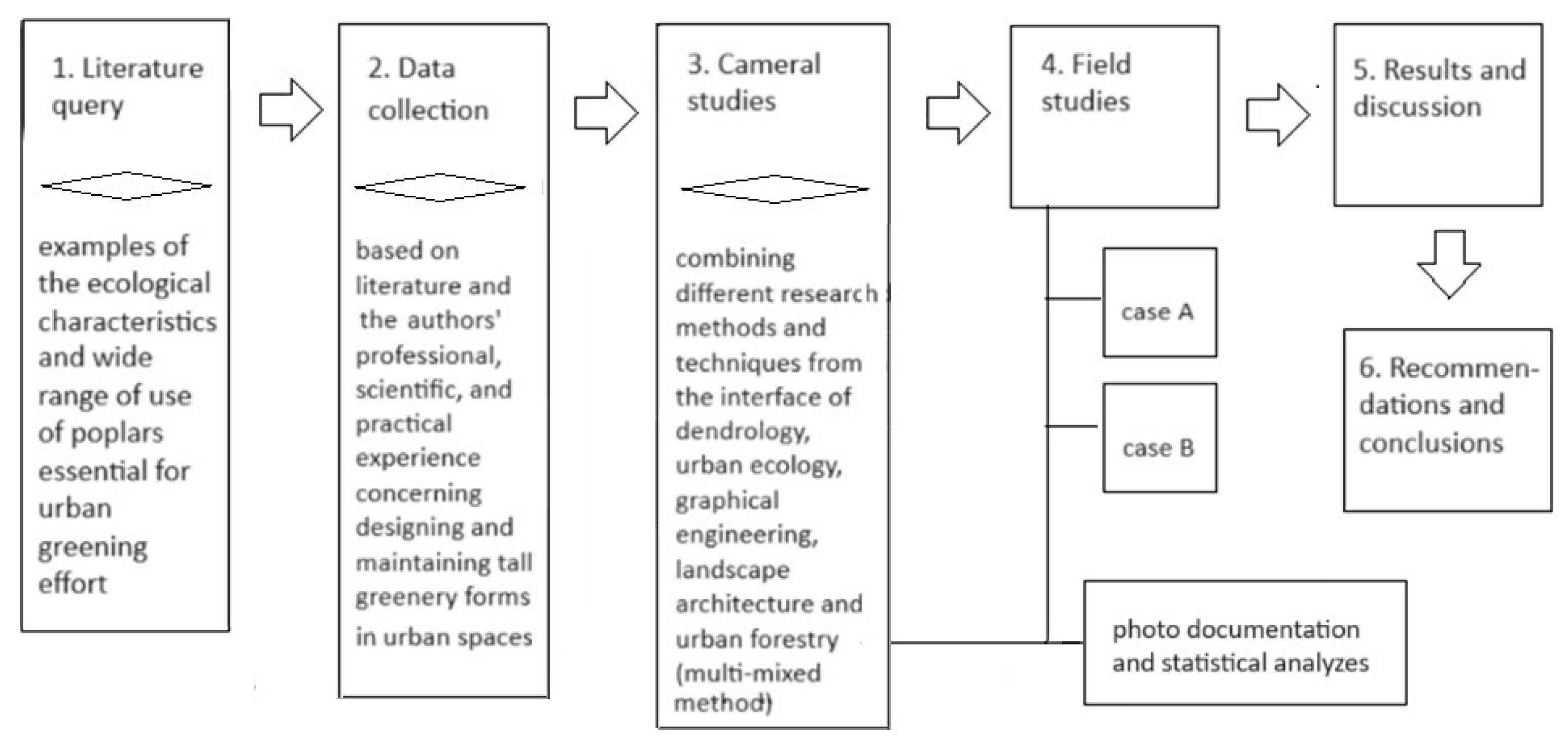
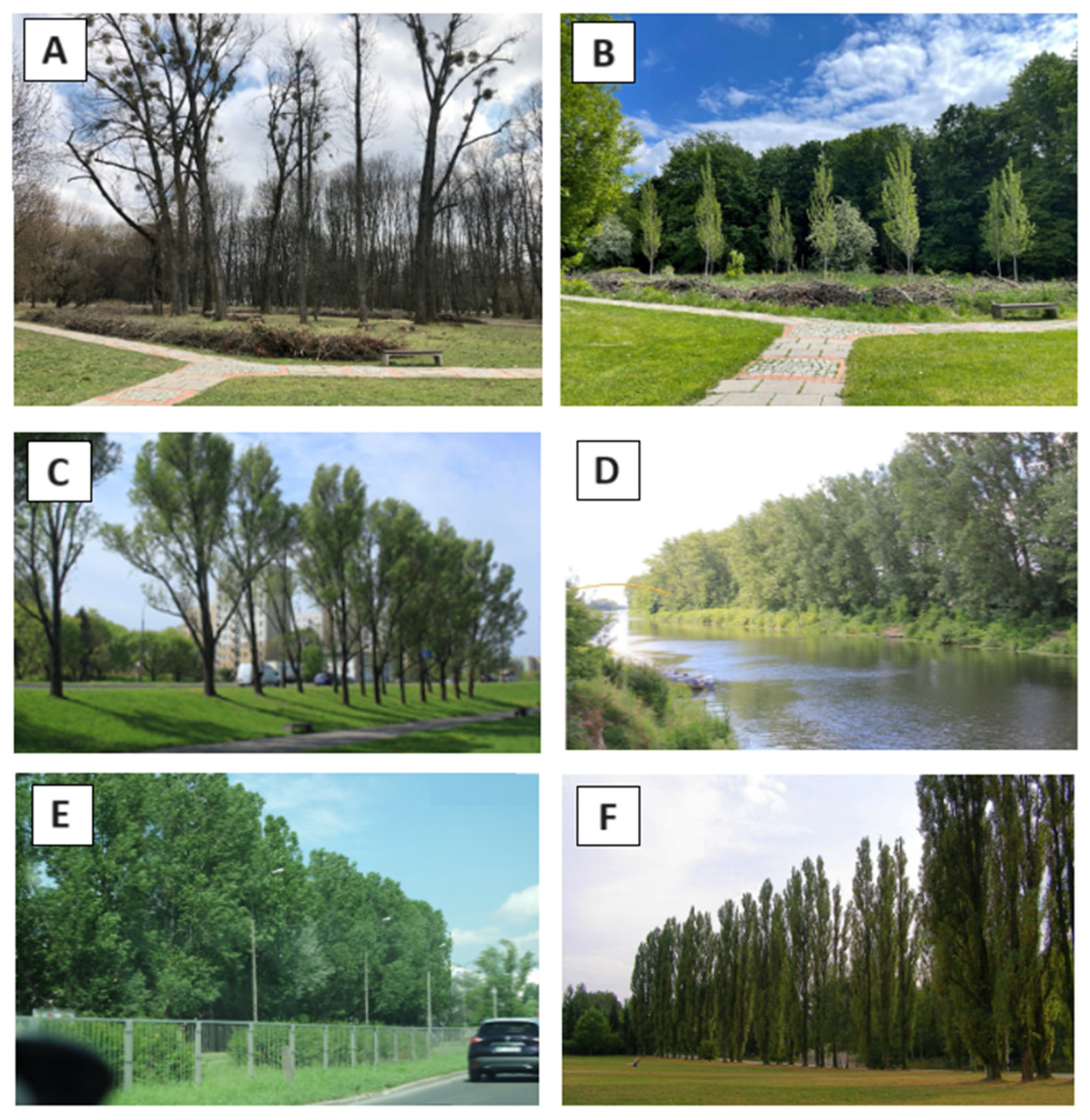
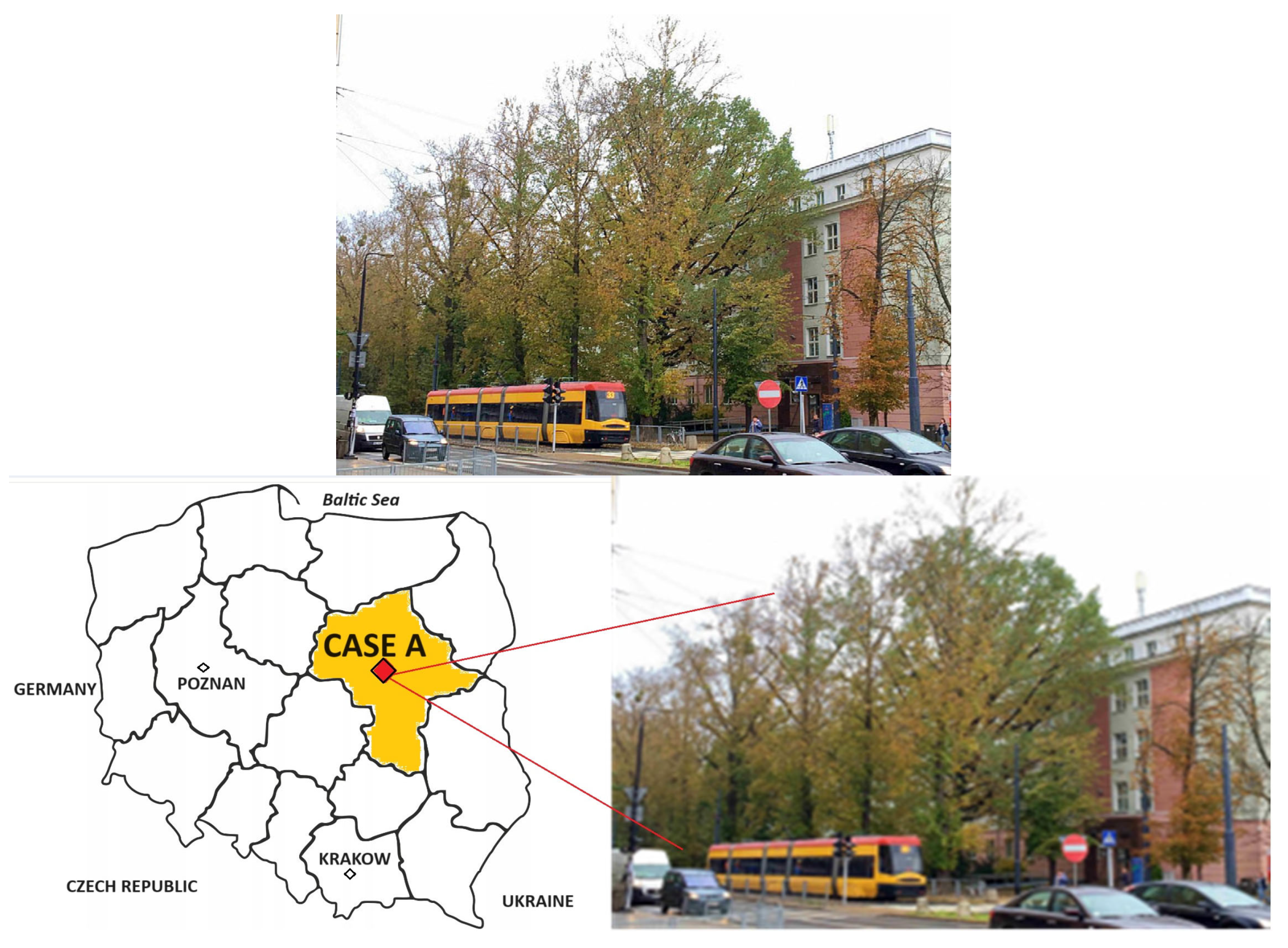

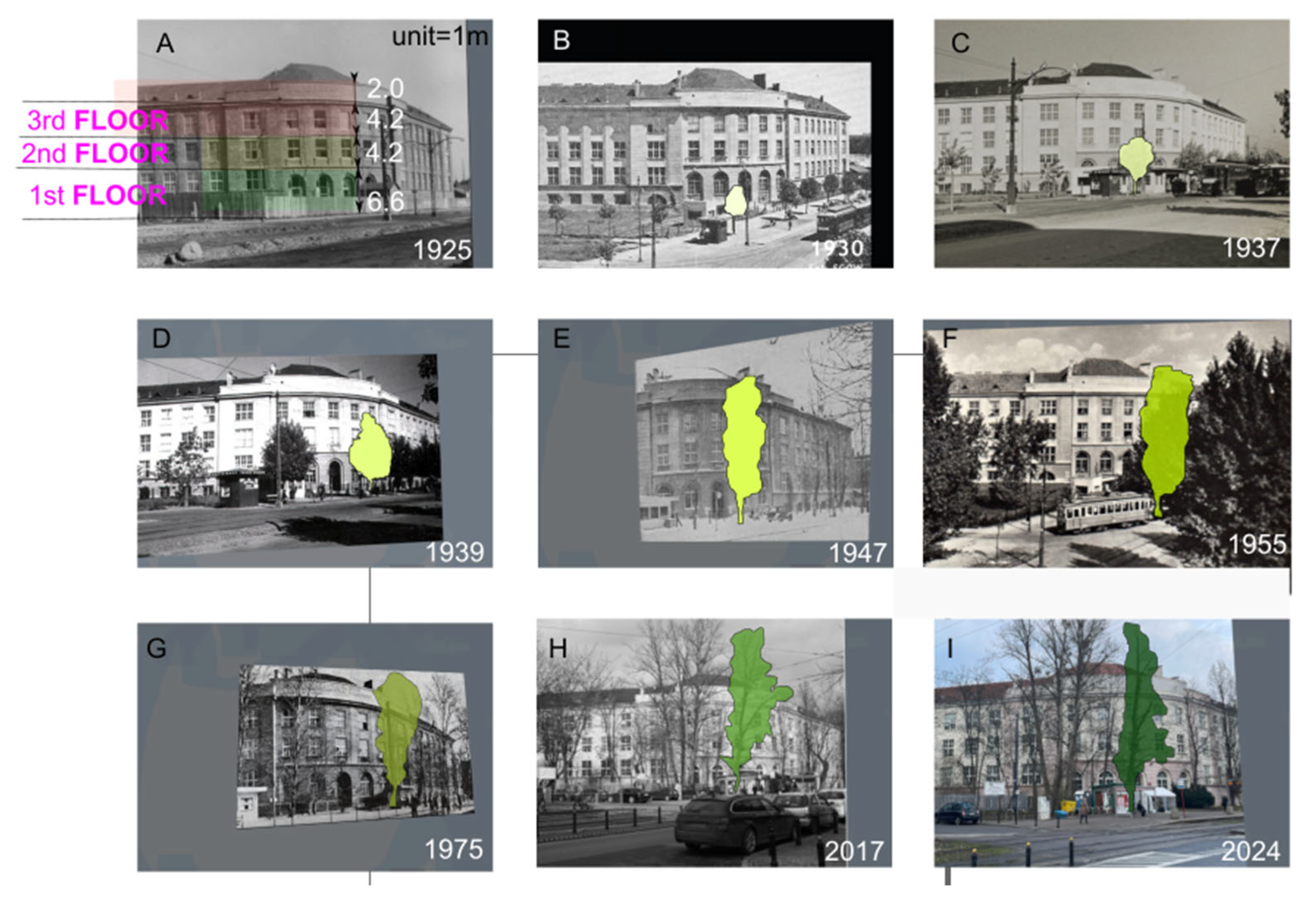

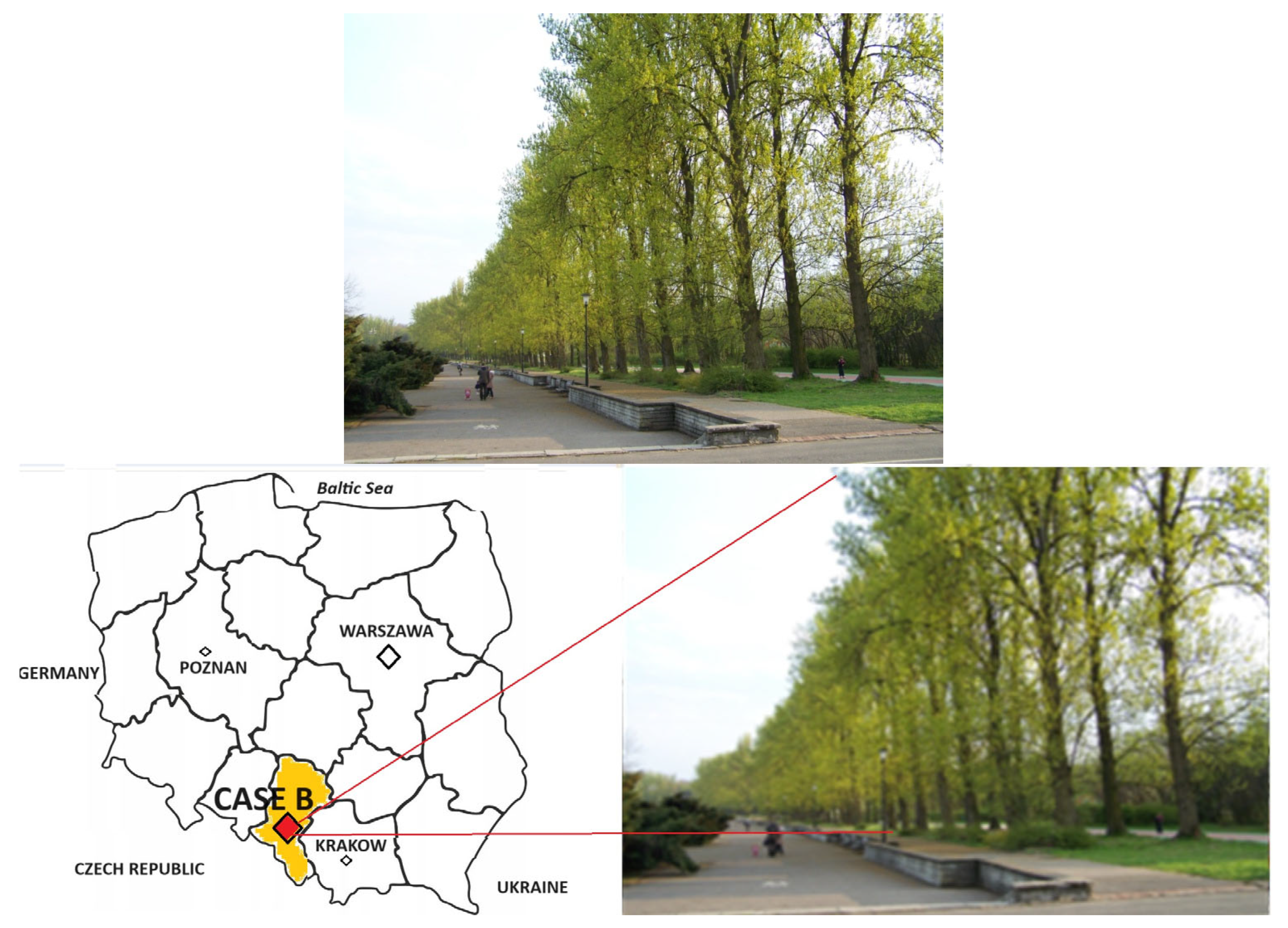


| Balsam Poplar Section (TACAMAHACA) | |
|---|---|
| Subsection | Selected Representative |
| American balsam poplars | P. balsamifera (syn. P. tacamahaca) P. trichocarpa |
| Asian balsam poplars | P. simonii P. maximowiczii P. laurifolia |
| Intra- and inter-sectional hybrids of balsam poplars | Europe: P. ×berolinensis (K. Koch) Dippel ‘Berlin’—Berlin poplar (male hybrid) P. ×berolinensis (K. Koch) Dippel ‘Petrowskyana’—Berlin poplar—so-called “Tsar’s”; P. ×berolinensis ‘Razumovskyana’ (both are female hybrids s) USA (in the 1920s by E.J. Schreiner and A.B. Stout—the so-called Schreinerian hybrids): Populus ‘NE 49’ or ‘Hybrid 194’ (P. x ‘Hybrid 194’) (male hybrid) Populus ‘NE 42’ or ‘Hybrid 275’ (P. x ‘Hybrid 275’) (male hybrid) Populus ‘NE 44’ or ‘Hybrid 277’ (P. x ‘Hybrid 277’) (male hybrid) Populus ‘Androscoggin’ (male hybrid), ‘Geneva’, ‘Oxford’ (female hybrids) |
| Parameter | Year | Age [Years] | Descriptive Statistics | t Test | ||
|---|---|---|---|---|---|---|
| Mean (+/−SD) | Me | Min–Max | ||||
| height [m] | 2012 [n = 16] | 85 | 23.87 (1.86) | 224.00 | 20.0–27.0 | p = 0.0175 t = −2.536 |
| 2024 [n = 12] | 97 | 25.5 (1.40) | 25.60 | 23.5–27.5 | ||
| circumference [cm] at 1.3 breast height | 2012 [n = 16] | 85 | 225.87 (50.98) | 224.00 | 116.00–321.00 | p = 0.4341 t = −0.794 |
| 2024 [n = 12] | 97 | 241.33 (50.93) | 244.50 | 146.00–339.00 | ||
| Parameter | Year | Age [Years] | Descriptive Statistics | ||
|---|---|---|---|---|---|
| Mean (+/−SD) | Me | Min–Max | |||
| height [m] | 2016 [n = 10] | 3 | 4.96 (0.10) | 5.0 | 4.8–5.1 |
| 2021 [n = 10] | 8 | 8.40 (0.51) | 8.5 | 7.6–9.5 | |
| 2023 [n = 10] | 10 | 13.90 (0.42) | 14.0 | 13.5–14.5 | |
| circumference [cm] at 1.3 breast height | 2016 [n = 10] | 3 | 12.90 (0.87) | 13.0 | 12.0–14.0 |
| 2021 [n = 10] | 8 | 63.65 (6.11) | 62.0 | 57.0–76.0 | |
| 2023 [n = 10] | 10 | 79.80 (5.12) | 82.0 | 74.0–86.0 | |
| crown average diameter [m] | 2016 [n = 10] | 3 | 2.17 (0.26) | 2.0 | 2.0–2.5 |
| 2021 [n = 10] | 8 | 4.50 (0.33) | 4.5 | 4.0–5.0 | |
| 2023 [n = 10] | 10 | 7.90 (0.26) | 8.0 | 7.5–8.2 | |
| Age | Parameter | Growth/1 Year | Correlation | ||
|---|---|---|---|---|---|
| R(X.Y) | t | p | |||
| 2–8 | height [m] | 0.69 | 0.9740 | 16.1 | <0.0001 |
| circumference 1.3 [cm] | 10.15 | 0.9831 | 20.1 | <0.0001 | |
| crown diameter [m] | 0.66 | 0.9689 | 14.6 | <0.0001 | |
| 8–10 | height [m] | 0.83 | 0.9853 | 20.8 | <0.0001 |
| circumference 1.3 [cm] | 5.38 | 0.8146 | 5.1 | <0.0002 | |
| crown diameter [m] | 1.33 | 0.9837 | 19.8 | <0.0001 | |
Disclaimer/Publisher’s Note: The statements, opinions and data contained in all publications are solely those of the individual author(s) and contributor(s) and not of MDPI and/or the editor(s). MDPI and/or the editor(s) disclaim responsibility for any injury to people or property resulting from any ideas, methods, instructions or products referred to in the content. |
© 2024 by the authors. Licensee MDPI, Basel, Switzerland. This article is an open access article distributed under the terms and conditions of the Creative Commons Attribution (CC BY) license (https://creativecommons.org/licenses/by/4.0/).
Share and Cite
Łukaszkiewicz, J.; Długoński, A.; Fortuna-Antoszkiewicz, B.; Fialová, J. The Ecological Potential of Poplars (Populus L.) for City Tree Planting and Management: A Preliminary Study of Central Poland (Warsaw) and Silesia (Chorzów). Land 2024, 13, 593. https://doi.org/10.3390/land13050593
Łukaszkiewicz J, Długoński A, Fortuna-Antoszkiewicz B, Fialová J. The Ecological Potential of Poplars (Populus L.) for City Tree Planting and Management: A Preliminary Study of Central Poland (Warsaw) and Silesia (Chorzów). Land. 2024; 13(5):593. https://doi.org/10.3390/land13050593
Chicago/Turabian StyleŁukaszkiewicz, Jan, Andrzej Długoński, Beata Fortuna-Antoszkiewicz, and Jitka Fialová. 2024. "The Ecological Potential of Poplars (Populus L.) for City Tree Planting and Management: A Preliminary Study of Central Poland (Warsaw) and Silesia (Chorzów)" Land 13, no. 5: 593. https://doi.org/10.3390/land13050593
APA StyleŁukaszkiewicz, J., Długoński, A., Fortuna-Antoszkiewicz, B., & Fialová, J. (2024). The Ecological Potential of Poplars (Populus L.) for City Tree Planting and Management: A Preliminary Study of Central Poland (Warsaw) and Silesia (Chorzów). Land, 13(5), 593. https://doi.org/10.3390/land13050593







